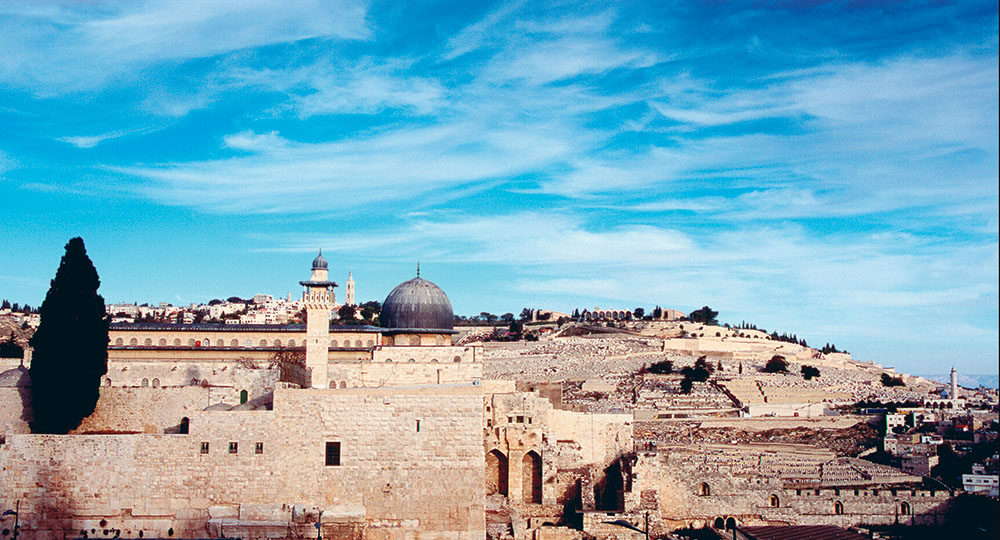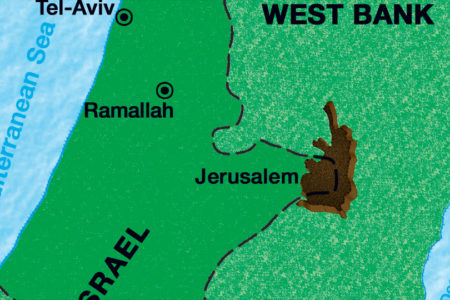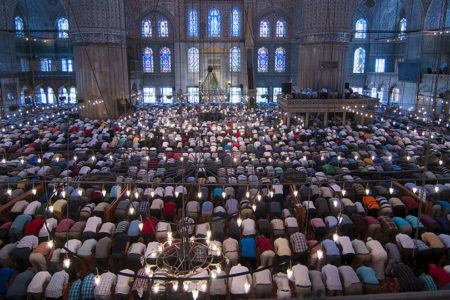God’s Holy Mountain
The phrase God’s holy mountain appears 18 times in the Old Testament; and though it defines two significant locations during different periods of history, in reality it points to the same piece of real estate on this earth. And by scanning the past, present, and prophetic significance of this most sacred plot of land, the most unique in the entire universe, we see God’s plan come into focus as it never has before.
The ancient Jewish prophet Daniel defined the location of “God’s holy mountain” when in prayer he begged the Lord to turn His wrath away from the city of Jerusalem, “thy holy mountain” (Dan. 9:16). Daniel also presented his supplications to the Lord for “the holy mountain of my God” (Dan. 9:20).
Other Scriptures advance our understanding of the term holy mountain of God. It actually refers to the Temple Mount in the city of Jerusalem, as in Daniel 11:45, which speaks of the spot where the Antichrist will establish the long-awaited Temple for the Jewish people at the onset of the Tribulation.
The first mention of the city of Jerusalem is in Genesis 14:18 regarding the King of Salem (Jerusalem), a mysterious personality named Melchizedek.
The “holy city,” Jerusalem, is mentioned another 764 times in both the Old and New Testaments from Joshua 10:1 to Revelation 21:10. In reality, what makes this city at the edge of a desert so important in the history of this world—past, present, and future—is that God has chosen Jerusalem and, in particular, the Temple Mount, as the spot where He will dwell among His people forever (Ps. 132:13-14).
The Temple Mount, as it is known today, is Mount Moriah, where God told Abraham to take his son Isaac and offer him as a sacrifice (Gen. 22). It is also the location of the threshing floor that King David purchased from the Jebusite Ornan (also called Araunah, 2 Sam. 24:18-25; 1 Chr. 21:18–30). The third king of Israel, Solomon, took seven years to build the first Jewish Temple on that same Mount Moriah, the Temple Mount (2 Chr. 3:1).
After the Babylonian Empire fell in 539 BC, Cyrus, leader of the Medo-Persian Empire, allowed the Jewish people to return to Jerusalem to rebuild the Temple on the same spot where the first Temple had stood: Mount Moriah, the Temple Mount (Ezra 1:2–4). This second Temple was actually remodeled into one of the most magnificent buildings in the world under the leadership of Herod the Great, taking some 46 years to refurbish.
It is interesting to note that almost 40 years exactly after Jesus predicted the Temple would be destroyed and not a stone would be left upon another, General Titus, leader of the powerful Roman army, ordered his men to level the Jewish religious center to the ground.
As the Roman army marched across the Kidron Valley from the Mount of Olives to the Temple Mount to dismantle this sacred Jewish structure, Titus is remembered to have said that Herod’s Temple was the most beautiful building he had ever seen. And the general had seen the greatest structures in the then-known world.
Enter Islam
After the devastation of the Temple in AD 70, this most sacred piece of real estate to the Jewish people lay somewhat idle and/or desecrated. Then the Muslim Omar built the Dome of the Rock there. This gold-domed structure on the original site of both the first and second Temples was built in 691 as a commemorative building. The structure has occupied the site of the Jewish Temples more than 300 years longer than did both Temples put together.
With the building of the Dome of the Rock, the tangible struggle for this most-contested plot of land in all of creation began. And that struggle has only intensified.
Most recently the highest-ranking Muslim cleric in the Middle East, the Mufti of Jerusalem, Sheikh Akram Sabri, astounded the Jewish and Christian world by claiming there is no evidence that a Jewish presence ever existed on the Temple Mount.
In addition to that pronouncement of arrogance, which the Mufti repeated to me when I interviewed the provocative Muslim cleric on the Day of Discovery television program, he also stated that the Al-Aqsa Mosque dates back to the time of Adam and the Garden of Eden. In a new study by Dr. Yitzhak Reiter, conducted for the Jerusalem Institute for Israel Studies, Reiter stated,
In the last generation, the Islamic and Arab history of Jerusalem has gradually been rewritten. At the heart of this new version is the Arabs’ historic right to Jerusalem and Palestine.
The main argument is that the Arabs ruled Jerusalem thousands of years before the children of Israel. In addition to building the Arab-Muslim case, the Muslim thinkers are formulating a denial and negation of the Jewish-Zionist narrative. Included in that effort is the de-Judaizing of the Temple Mount, the Western Wall, and Jerusalem as a whole.
Rewriting History
Muslims around the world are slowly dropping the name Islam gave to the Temple Mount complex, Haram al-Sharif, which gave it its status as the third holiest site in Islam. Instead, the Islamic world is reverting to exclusive use of the earlier name, Al-Aqsa, which it says appears in the Qur’an. The term did only refer to the pewter-domed Mosque at the southern end of the Temple Mount.
The term Al-Aqsa now is being used to refer to the entire Temple Mount complex, including the Western Wall, and not to the mosque alone. This new concept, plus the tradition connecting the three mosques in Mecca, Medina, and Al-Aqsa, is being used by the Palestinians to exert pressure on Muslim states by forcing them to uphold the position that contends, “Making a mockery of Al-Aqsa will lead to a mockery of the holy sites of Mecca and Medina.”
The Palestinian Authority-appointed Mufti of Jerusalem, Sheikh Sabri, claims that a verse in
the Qur’an mentions Al-Aqsa mosque and adds, “whose surroundings we have blessed,” thus meriting an expanded interpretation. The “surroundings” are not narrowly defined, as was the case in the past. They now provide opening for the interpretation that Al-Aqsa refers to all of Jerusalem and, most recently, all of Israel.
Sabri says there are no remnants proving the Jewish claim that a Jewish Temple stood on the site. This mindset goes along with the new “history” that says accounts of the first and second Temples are nothing but lies fabricated by the Jews. In public discourse among Arabs, participants regularly add the word al-maz’um—that is, “the presumptive” or “fabricated”—when referring to the Jewish Temple.
Recently appearing on the Internet site of the northern branch of the Islamic Movement was an article in which Egyptian archaeologist Abed al-Rahim Rihan Barakat, manager of the archaeological site at Dahab in Sinai, wrote, “The myth of the fabricated Temple is the greatest crime of historical forgery.”
There is also a fatwa (Islamic ruling) on the Internet site of the Waqf in Jerusalem that states neither David nor Solomon nor Herod built any Jewish Temples; rather, they repaired some thing that had been there since the time of Adam. In line with that fatwa is Mufti Sabri’s statement to me on Day of Discovery, claiming the Al-Aqsa Mosque dates all the way back to the time of Adam and the Garden of Eden. The mufti’s statement about the connection of Al-Aqsa Mosque and the Garden of Eden is, I believe, at the heart of the present-day controversy surrounding the Temple Mount. For thousands of years the Jewish tradition has been that the stone under the gold domed Dome of the Rock is the “Foundation Stone,” the location of the creation of Adam by the Lord.
Thus the tradition of many religious Jews is that the original site of the Garden of Eden is what we know today as the Temple Mount. In a conversation I had with Rabbi Chaim Richman, who is involved with the Temple Institute and its efforts to rebuild the Temple on the Temple Mount, Rabbi Richman made what to me was a compelling case for his contention that the Garden of Eden was located there some 6,000 years ago. It begins with a study of the words holy mountain in the Old Testament.
That phrase is used 18 times in the Bible. In Ezekiel 28:14, 16 that phrase and mountain of God refer to the Garden of Eden in its context. The other 16 times the phrase refers to the Temple Mount in Jerusalem (i.e., Dan. 9:16, 20). A close study leads some of us to believe that the Temple Mount is indeed the site of the Garden of Eden.
Thus this spot is sacred to Jews, Muslims, and Christians.
God choose the Temple Mount for the House where His Son, Jesus Christ, will dwell forever among His people, the Jewish people. That Temple will be built by Jesus Himself (Zech. 6:12) when He returns to the earth at His Second Coming. Until then, the Temple Mount will remain a center of controversy and conflict as Jews and Muslims battle for its control.
There is only one solution: the return of Jesus Christ to claim His rightful ownership of the location for His eternal reign.








Hello! I enjoyed your article, and it’s very well-written and factual — except for the part about Melchizedek. Melchi = King of Zedek= Righteousness It’s not a person: it’s a title. According to the Dead Sea Scrolls, this is a priestly order like the Aaronic priests or Levi priests, but a special one that only includes priestly kings. Noah’s son Shem was in the line — he was the priestly king of Salem. It was King Shem of Salem that brought out the bread and the wine sacraments to celebrate and anoint Abram/Abraham as the next Melchizedek after Abram/Abraham defeated the giant kings, and the Dead Sea Scrolls explain that he was the final Melchizedek before the Messiah would come to rule and reign as the ultimate Melchizedek.
The Essenes that preserved the Word and history of the Israelites in the Dead Sea Scrolls in the Quram caves all knew this at the time, and there is evidence that John the Baptist was the head of the Essenes at one time and a school of prophets. Don’t take my word for it — research it yourself. I think you will really enjoy knowing all of this firsthand.
I am an M. Div., so I see everything you have written, but I just want to throw in something that keeps coming to me strongly when I read the passage since they started building the new digital/a.i. city of Neom in Saudi Arabia which includes the area of Mt. Sinai. I just keep seeing this new prime piece of real estate palace/tent being built between Mt. Sinai and the Red Sea. And perhaps the new Neom is considered the last manifestation of Babylon. The area of the “city” is vast – like a huge “tent” – purportedly 33x the size of NYC. I can’t shake these questions. What do you think of this besides what you’ve already written?
Thank you so much for posting this.
Thank you for this information. I agree with it inclusively.
Isaiah 27:13 “So it shall be in that day: the great trumpet will be blown; they will come, who are about to perish in the land of Assyria, and they who are outcasts in the land of Egypt, and shall worship the LORD in the holy mount of Jerusalem.
Where does it say in scripture that “At the sound of the Shofar Jesus will return and strike his foot upon the Holy Mountain”?
Zechariah 14:4 His feet touch the Mount of Olives. Even though the Temple Mount is west, it is still the general area.
This is most informative for me , and it also answers a lot of questions .
I like your name 😀